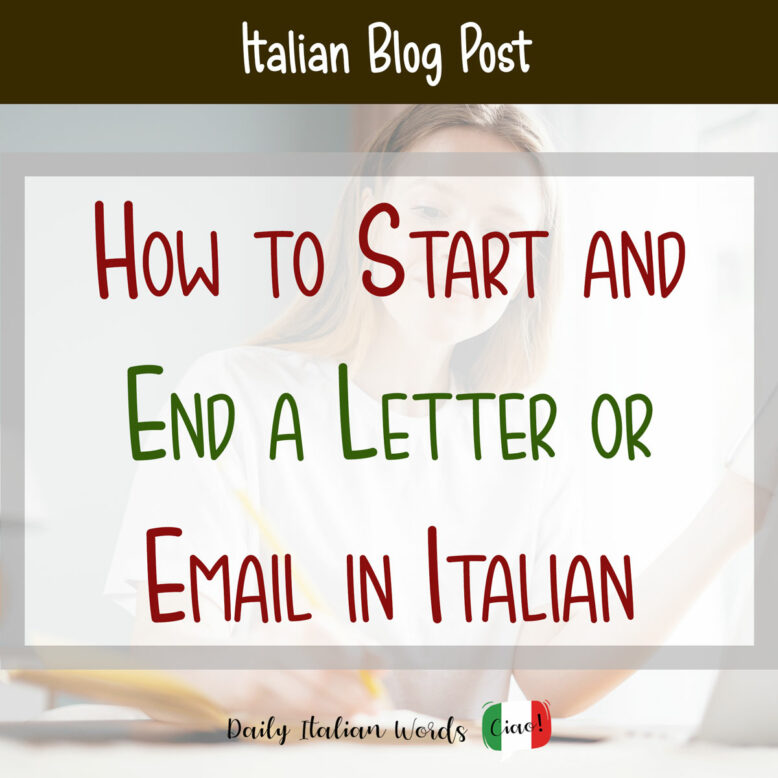Letters, although less used today, and emails are both useful ways to communicate and to inform others about specific situations. You can use them for informal reasons, such as catching up with an old friend. Or they can be used to reach out to a company about a potential job offer, or to discuss work projects with clients or co-workers.
In this digital world, emails are becoming more and more indispensable for a wide range of activities that otherwise couldn’t be carried out. This is why it is really important to know how to write them and to not be unprepared when having to compose one. This is especially true in Italy, where people have maintained a certain formal style that at times may seem a bit antiquated.

How to start a letter or email in Italian
It is no secret that depending on the recipient, the structure of the email or letter’s content changes. More precisely, we must pay special attention to the words and expressions used when the receiver is someone you don’t know or the situation requires more polished and formal language.
When it comes to writing an informal email, you are allowed to use everyday language in Italian. For instance, in an informal setting, you can start a letter or email in Italian in the following way:
Cara / Carissima Giulia,
Dear / Dearest Giulia,
You always put the comma at the end of the name and start a new paragraph where you generally write an introduction – not that different from English in this case. It gets harder when you must write to people with the highest qualifications or who belong to specific professional categories. In actual fact, in Italian you may put the abbreviation of the job qualification before the name. Let’s see how it really works.
First of all, in formal situations Caro and Carissimo are substituted by Gentile or Egregio in the following way:
Gentile / Egregio Sig. Francesco Pio,
Dear Mr. Francesco Pio,
However, when the receiver has an acknowledged title, you can show politeness by substituting Signor (Mister) or Signora (Mrs) with their qualifications or professional occupation.
Here is a list of the abbreviations used instead of Sig. (Signore) or Sig.ra (Signora):
- Dott. / Dott.ssa (Anyone who has graduated from higher education or works as a doctor),
- Prof./ Prof.ssa (professor, mostly high school and university),
- Pres. (High school or university dean),
- Avv. (Lawyer),
- Geom. (Surveyor),
- Ing. (Engineer),
- Arch. (Architect),
- Rag. (Accountant),
There are many possible abbreviations, but these are enough to get you started. Remember, however, that if you don’t know what someone’s profession is in Italian, Signore and Signora work fine as well.
After you have addressed the recipient, you can move on to the body text.
How to write the body of a letter or email in Italian
First of all, it is considered more polite to start an email introducing the content with formal structures such as:
- Con la presente le comunico quanto segue… (I hereby inform you as follows …)
- In riferimento alla sua/vostra richiesta… (In reference to your request …)
- In riferimento a quanto in oggetto… (In reference to this subject matter …)
- Come da accordi… (As per agreement …)
- Le invio in allegato… (Please find attached…)
- In risposta alla sua/vostra mail in data…le/vi confermo/sottoscrivo che… (In response to your email dated…I can confirm that…)
- La/Vi contatto in merito al colloquio telefonico per… (I am contacting you with regards to the phone interview to…)
- Con la presente siamo a formalizzare… (We hereby formilize that…)
These are some forms you can use to start your formal letter or email in Italian. It is always be best to start by giving the reason you are writing this email and briefly introducing yourself to help the receiver understand who is he or she is talking to.
It goes without saying that the main part of the email should be located in the second and third paragraph. Here is where you can write the meaningful content and object of the e-mail. In this specific part, you don’t really need to follow a precise structure. However, it is recommended that you keep a polite and formal tone from start to finish.
Things are pretty different when it comes to writing an informal letter or email. In this case, remember that in Italian emails, people tend to get straight to the point without too many frills.
In English, by comparison, you can leave some initial space for a preamble, a parenthesis where you ask after the receiver. Indeed, the following formula is often used: I hope you’re doing well / I hope this e-mail finds you well.
These ways to introduce an email can be also used in Italian, but in general, they are omitted. Nevertheless, if you’d like to start the letter with these expressions, you can feel free to use the following wording:
- Spero tu stia bene, (I hope you’re well)
- Come stai? (How are you?)
- Spero vada tutto bene, (I hope everything is well)
At the end of the day, it’s your choice to opt for a more long-winded and structured email or to go straight to the point. Italians will accept either formula without any qualms.
How to end an email in Italian
There are different ways to end an Italian letter or email according to the degree of formality with which it is written. For example, an informal letter can simply end as follows:
- Ti abbraccio forte (a big hug)
- Un abbraccio (a hug)
- Saluti (Greetings or goodbye)
- Buona continuazione (lit. “Good continuation” – it means “good luck / continue to enjoy whatever you are doing)
- A presto (See you soon)
The forms adopted to end a formal letter in Italian are quite different. Depending on both the degree of formality and the language ability of the author, they can have an infinite variety of shades. Let’s have a look at some of the most used ones and their very literal translations into English!
- Cordiali Saluti / Un Cordiale Saluto (Kind regards)
- Grazie e Cordiali Saluti, (Thank you and kind regards)
- Distinti Saluti, (Best regards / Yours sincerely)
- Le porgo i miei distinti saluti, (I offer you my most cordial greetings)
- La prego di voler gradire i miei più distinti saluti. (Would you please accept my most cordial greetings)
- In attesa di una Sua risposta, Le porgo i miei più cordiali saluti. (Waiting for your response, I offer you my most cordial greetings)
- Ringraziando anticipatamente per la sempre cortese collaborazione porgo cordiali/distinti saluti. (Thanking you beforehand for your continued courteous collaboration, I offer you cordial greetings)
- Ringraziando per la cortese attenzione che vorrà accordarmi porgo cordiali/distinti saluti. (Thanking you for the courteous attention that you will grant me, best regards)
- In attesa di riscontro, resto a disposizione per chiarimenti e porgo cordiali saluti. (I await your reply, I am available for any further information and I offer you cordial greetings)
With these tips, you should be able to write an email or letter so complete and efficient that you may even give the impression of being an Italian native speaker! And don’t forget that in Italy the P.S., Post Scriptum, is often used at the end of the letter to add something that has nothing to do with the main content or to share some information that you forget to include in the email.
About the author: Fabio Guarino
As a Linguist and Language Specialist, working as a Freelance Content Writer and SEO Marketer allows me to combine my passions and interests with my career. My favourite thing about working with languages is playing with words. And this is something I’ve always dreamed about since I started to wander the globe and study languages.

Fabio Guarino is a Linguist and Language Specialist who operates as a Freelance Content Writer and SEO Marketer. He considers himself fortunate to be able to blend his passion for his native language, Italian, along with English and Spanish, with his career.


